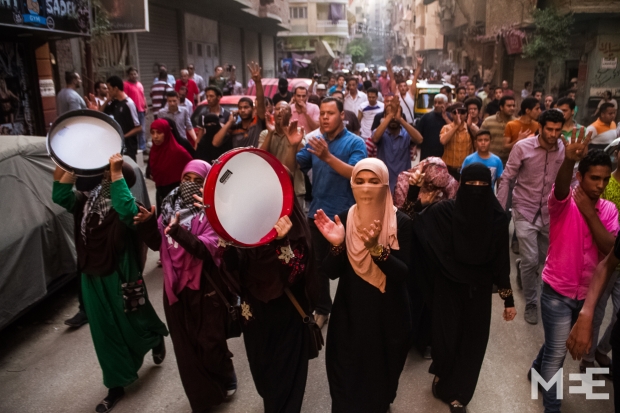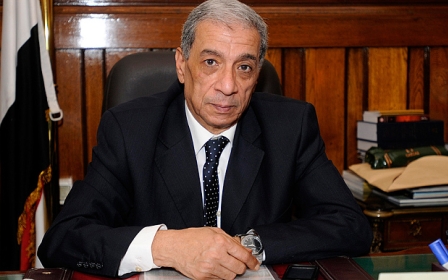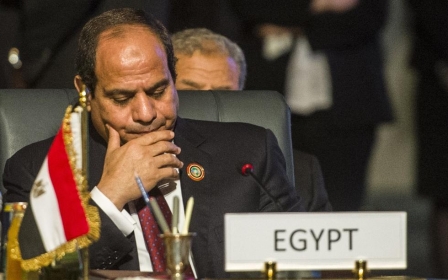Protests held in Egypt mark two years since Morsi’s overthrow

The alleyways and small side streets of Al-Mataria neighborhood in Cairo are always heaving and bustling, crowded with young children playing football, tuk tuks (automotive rickshaws) being manned by chatty teenagers, vegetable vendors yelling atop their carts being pulled along by horses or donkeys, women in black veils (Islamic niqab) and men with beards.
But on 30 June 2015, the second anniversary of the popularly backed coup led by current President Abdel Fattah al-Sisi, the small streets of the crowded neighbourhood were full of protests, shouts, flares, flying bullets, Molotov cocktails and tear gas.
The protests came at an already tense and critical moment, following the assassination of Egypt’s top public prosecutor Hesham Barakat while travelling back to his house in his bulletproof car, and followed too by the ominous words from President Sisi at Barakat's funeral the next morning in which he accused the detained former president Mohamed Morsi of being responsible for the assassination and calling for changes in the laws to allow for faster executions.
This neighbourhood is no stranger to protests. Directly after the 2013 coup, it was witness to daily protests organised by members of the Muslim Brotherhood and supported by other Islamic movements and groups. These protests were violently stifled and attacked by the police, who used live bullets to deal with the protests, especially on important occasions. The crowded low-income neighbourhood was full once again yesterday, as adherents of various Islamic groups gathered to commemorate three decades of struggles.
As an MEE photographer, I was there on the third anniversary of the 25 January revolution in 2014 and witnessed more than 150 people being killed and more than 500 injured in clashes in Al-Mataria Square and around Al-Mataria’s notorious police station.
I was also there on the fourth anniversary of the revolution about six months ago, when about 20 people were left dead in clashes between the protestors and the police. Among the dead was an 11-year-old Christian boy, whose only fault was that he was passing by when the police started shooting at the protestors.
The police tactics over the past two years to suppress and strangle protests have proven to be effective in that the frequency of protests and the numbers attending them have dwindled in comparison to the much larger gatherings exactly two years ago.
The police tactics include late-night detentions, undercover police officers participating in the protests to locate the organisers and catch them by force at the end of the protest, and, of course, many accounts of extreme torture in notorious police stations.
The reports of abuse of detainees accused of protesting has in certain cases resulted in death, as happened in the case of Karim Hamdy, a 27-year-old lawyer who was tortured to death on a cold February evening. In fact, Hamdy’s case and the widely shared pictures on social media websites of his bruised body in the morgue have put the police under the spotlight and have forced them investigate the case.
As a result of these investigations, two police officers had to stand trial for misusing their power, but their identities remain secret due to a gagging order issued by the now dead public prosecutor, Hisham Barakat.
Still protesting
Through all the difficulties, the protests are continuous and are held at least three times a week. 30 June 2015 was no exception. Two protests started at 5pm in front of mosques in the neighbourhood. The majority of the protesters were young men aged between 18 and 25, with a small number of women, mostly in their early twenties.
They chanted slogans against the "military regime" ruling in Egypt, with some of the same slogans used by the 25th January revolution including the most famous one, “People want the downfall of the regime.”
After about five minutes of the protest groups meeting, they were attacked by seven or eight policemen firing live rounds at the crowd. The young protestors were able to hold their own against them and drove them back using fireworks and stones. The protests continued on their way with the loud, energetic Islamic chant of “Allah Akbar / God is Great.”
It was clear that the organisers of the protest had individuals following the pursuing ACBs, informing their comrades of their exact location. Consequently the protesters were able to avoid the police for about an hour, running and shouting through the labyrinth of alleyways that differentiate Al-Mataria neighborhood and other local working-class areas.
Eventually the police ACBs (military vehicles) were able to catch up with the protest and started shooting tear gas bombs which had a powerful effect upon the protesters, alongside bullets that injured several protesters in the face. The tactics of the young men and their fireworks were no match for the heavy ACBs, and five minutes later the protests were dispersed with people running and fleeing into the back alleyways. More protests are expected.
New MEE newsletter: Jerusalem Dispatch
Sign up to get the latest insights and analysis on Israel-Palestine, alongside Turkey Unpacked and other MEE newsletters
Middle East Eye delivers independent and unrivalled coverage and analysis of the Middle East, North Africa and beyond. To learn more about republishing this content and the associated fees, please fill out this form. More about MEE can be found here.







